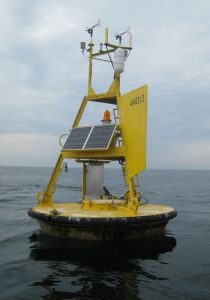 A NOAA data buoy in the Atlantic Ocean east of Boston, MA
A NOAA data buoy in the Atlantic Ocean east of Boston, MA
One of the greatest problems with adjusting to climate change is the uncertainty in climate models. Climate scientists use models to demonstrate the statistical likelihood of certain futures in a certain region. They have evolved over time to include more data which has made them more accurate. Climate models can be hugely helpful in making decisions for the future because they can produce a range of possibilities for the future based on the factors they include.
They are especially helpful when the majority of models predict a small range of possibilities that can inform mitigation efforts. In order to best prepare for the future we need to have some idea of what it might look like. Policy makers and organizations can use these models to prepare for the futures that are most likely. For example, if a model predicts that a certain area will see an increase in annual rainfall, infrastructure can be changed to accommodate that.
However these models can vary in their accuracy. As models get more specific and focus on smaller areas, the information they provide can become harder to use because they can produce a wide variety of possible futures. This is also a problem because climate change take uncertainty in models as reason to doubt the basic facts of climate change. This is also difficult for decision making because predictions can vary widely and models can disagree. For example, when climate models focus in on Nepal they can vary hugely in their predictions. There are several reasons for this, especially in Nepal. The region is very unique because of the huge variation in elevation across the country so already the weather across the country varies greatly. Additionally, Nepal has a dry season and a wet season when most of the rain falls in a short amount of time. Yearly rain predictions don’t help much to say when the rain might occur and where within the country. The climate models predict anything from a lot more rain to more droughts and a large range of possible temperature increases. This complicates decisions that can be made because it is hard to know which future to prepare for.
Mitigation efforts are going to be expensive and in some cases traumatizing, especially when people decide to migrate, people aren’t going to want to invest in changes if they aren’t shown sufficient evidence. Not only might politicians and organizations make ill informed decisions but they might not make any decisions at all. Additionally, weaker evidence for a certain future will provide more challenges for people trying to implement a certain plan. For example, politicians in the United States who are trying to implement climate change mitigation strategies are constantly met with opponents who say that there simply isn’t enough evidence to warrant spending huge sums of money on mitigation. This goes to show that while climate models can be very helpful, they can also have their shortcomings. It is important to keep in mind that being less helpful in certain regions does not make them illegitimate sources of information in others and that they should be analyzed within the context of the geography of the regions they are describing.
